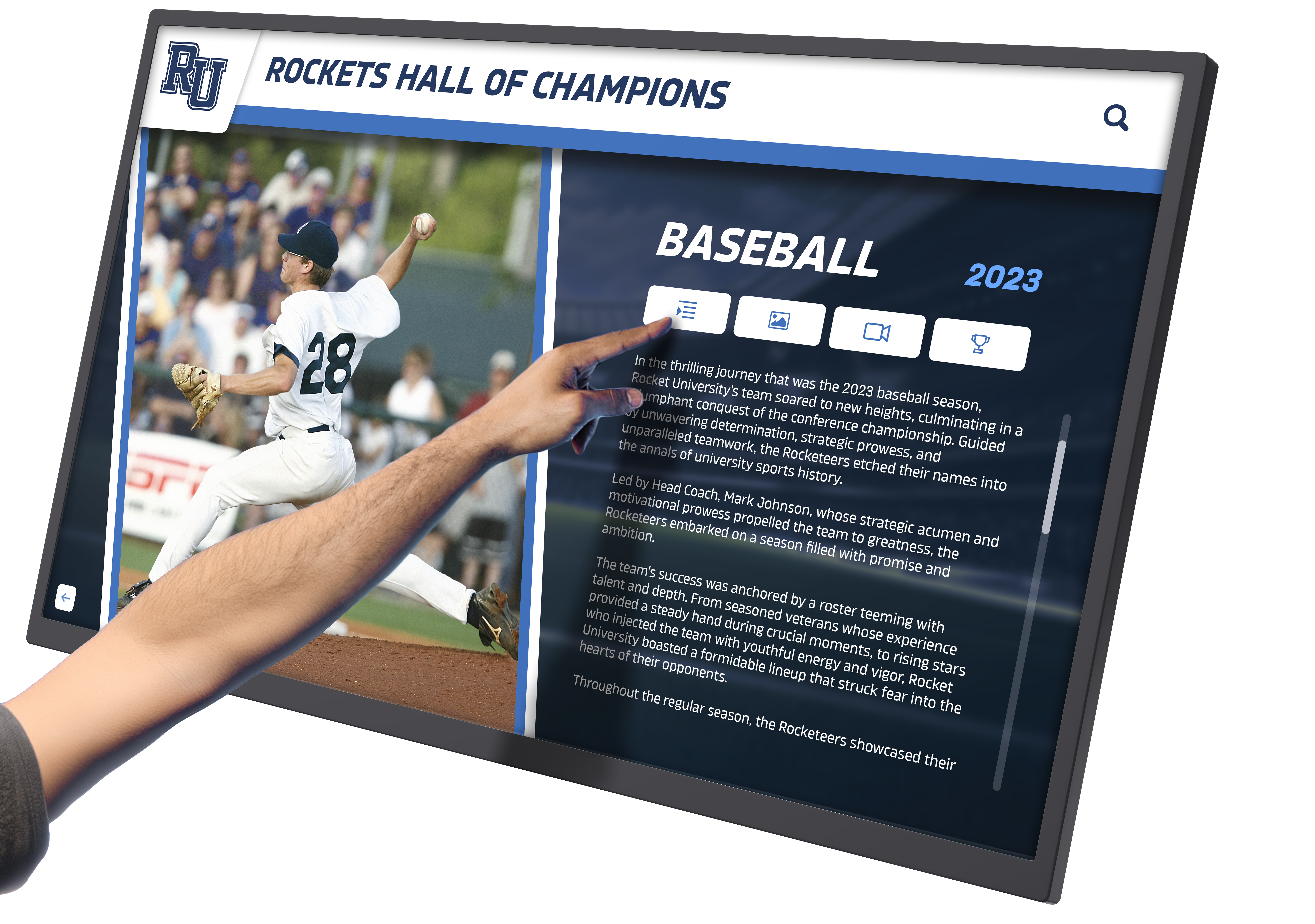A chance encounter between one of our Rocket Alumni Solutions team members and an alumnus from Noble and Greenough School in Boston recently demonstrated something powerful: when schools make their historic team photos accessible online, they create unexpected moments of connection that strengthen alumni relationships for years to come.
The alum hadn’t seen his high school team photos in years—perhaps decades. Within seconds of hearing about his school’s digital recognition solution, our team member pulled up the web-accessible interface on a phone, searched for the alumnus by name, and instantly displayed all his old team photos from his high school sports career. The reaction was immediate and emotional. The alumnus asked for the link on the spot, and later that same day, he shared the photos with his wife and daughter, writing back to express how meaningful the experience was for his entire family.
This wasn’t a planned demonstration or a staged marketing moment. It was a spontaneous encounter that revealed a fundamental truth about the value of digitally preserved, mobile-accessible school photo archives: when alumni can access their memories instantly from anywhere, those connections create lasting emotional bonds that benefit both individuals and their schools.
This comprehensive guide explores why team photos archives matter, how mobile accessibility transforms alumni engagement, and what schools should consider when making historic sports photos available to their communities. Whether you’re a school administrator, athletic director, alumni relations professional, or archivist, understanding the power of accessible team photo collections helps you better serve your community while preserving institutional memory.
The Hidden Value of Team Photos Archives
Team photos represent far more than simple visual documentation of athletics programs. Each image captures specific moments in student athletes’ lives—the pride of making varsity, the camaraderie of championship seasons, the dedication of early morning practices, and the relationships formed through shared competition and teamwork.
Why Team Photos Matter to Alumni
For many alumni, participation in high school sports represented defining experiences that shaped their character, taught valuable life lessons, and created lasting friendships. Team photos serve as tangible evidence of these formative experiences—visual proof of accomplishments, connections to teammates they haven’t seen in years, and reminders of who they were during those crucial developmental years.
Emotional Connections:
- Recognition of personal athletic achievement and dedication
- Visual reunion with teammates and coaches from decades past
- Nostalgia for simpler times and formative experiences
- Pride in being part of team traditions and school history
- Connections between their athletic experiences and current identities
Social Significance:
- Conversation starters at reunions and alumni gatherings
- Shared memories strengthening bonds with former teammates
- Stories to share with children and grandchildren
- Documentation of family legacy when multiple generations attended
- Social media content connecting with old friends
Schools implementing comprehensive alumni engagement strategies discover that accessible team photo archives serve as powerful engagement tools that require minimal ongoing effort while delivering consistent value.

The Challenge of Physical Photo Archives
Traditional approaches to preserving team photos create significant accessibility barriers that limit their value to alumni communities. Physical photo collections typically suffer from several critical limitations that digital solutions address comprehensively.
Physical Storage Constraints:
- Limited wall space for displaying decades of team photos
- Deteriorating photo quality in aging trophy cases
- Storage room archives accessible only during office hours
- Photos stored in boxes or albums requiring hands-on searching
- Geographic barriers preventing access for distant alumni
Discovery and Search Limitations:
- No practical way to search for specific individuals across years
- Time-consuming manual browsing through multiple seasons
- Difficulty identifying which years specific alumni participated
- No cross-referencing between sports or activities
- Missing context about team accomplishments and records
Preservation Risks:
- Fading caused by light exposure in hallway displays
- Physical damage from handling and environmental conditions
- Water damage risks in basement or storage areas
- Loss risk from facility renovations or relocations
- Single point of failure with no backup copies
The story from Noble and Greenough perfectly illustrates these limitations. Before digitization, this alumnus simply had no practical way to view his team photos. They existed somewhere in the school’s archives, but accessing them required physical presence, time, advance planning, and staff assistance—barriers so significant that most alumni never overcome them.
Mobile Access: The Game-Changing Difference
The transformation from physical archives to mobile-accessible digital collections fundamentally changes the alumni experience. When team photos become searchable and viewable from any smartphone or device, accessibility barriers disappear entirely.
Instant Availability Anywhere, Anytime
Mobile accessibility means alumni no longer need to visit campus, wait for business hours, or navigate physical archive systems. The Noble and Greenough alumnus accessed decades of his team photos within seconds—right in the moment when nostalgia and interest were strongest. This immediacy creates emotional experiences that scheduled archive visits simply cannot match.
Modern digital recognition platforms enable schools to provide 24/7 access to comprehensive photo collections through intuitive web interfaces optimized for all devices. Alumni can search by name, browse by year, filter by sport, and share discoveries with family and friends—all from wherever they happen to be when curiosity or nostalgia strikes.
Immediate Access Benefits:
- Search and view during chance encounters and conversations
- Share photos with family and friends in real-time
- Access during reunion planning when memories surface
- Browse during work breaks or commutes when thinking about school days
- Discover photos while reminiscing with old teammates
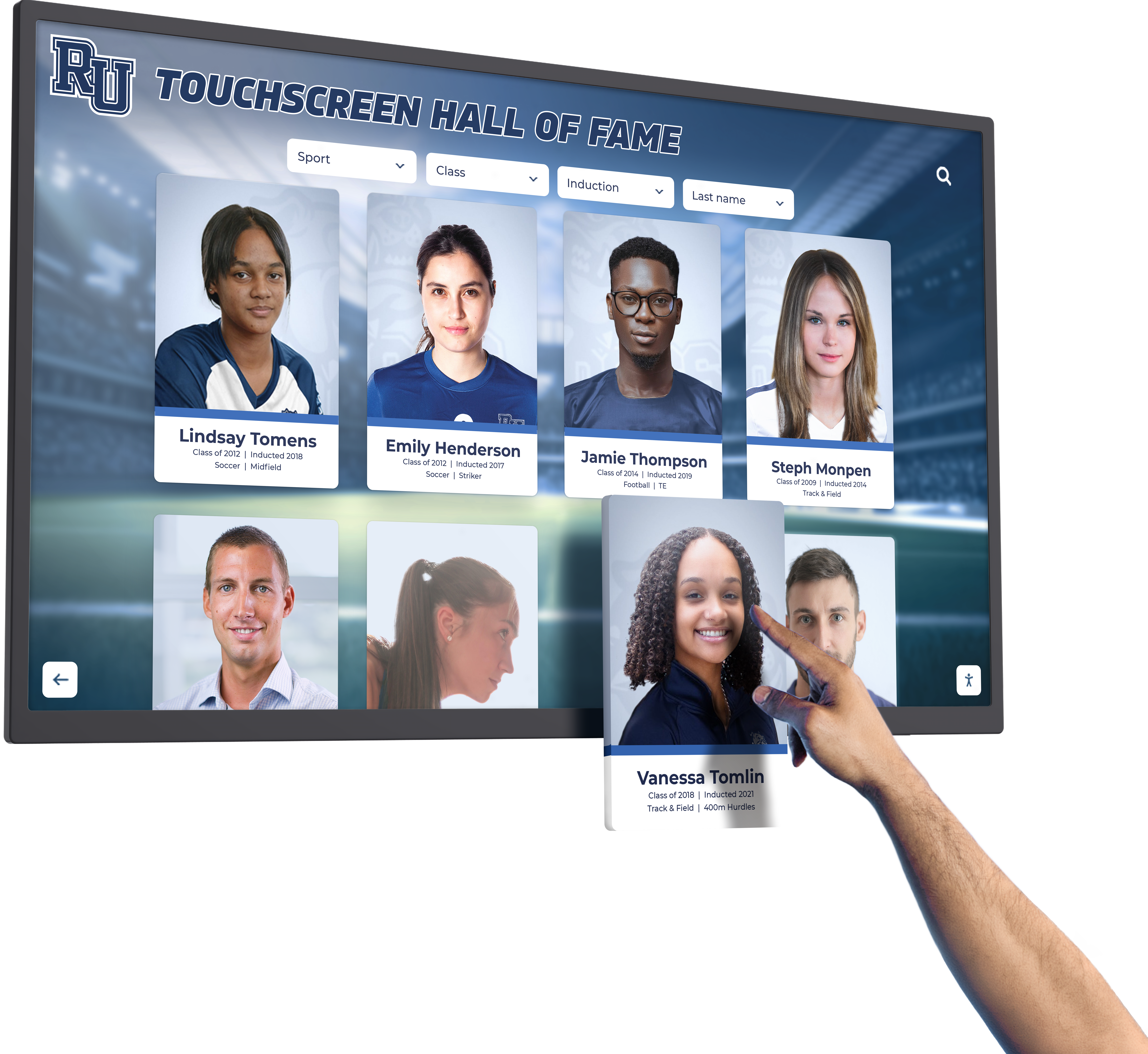
Searchability Transforms Discovery
Physical photo archives require tedious browsing—examining every team photo from multiple years hoping to find specific individuals. Digital searchability eliminates this frustration entirely. Alumni enter their names and instantly see every team photo in which they appear across all sports and all years.
This search capability creates discovery experiences impossible with physical archives. Alumni often find photos they didn’t know existed—junior varsity teams they’d forgotten about, photos from sports they tried briefly, or group shots from championship celebrations. Each discovered image triggers memories and strengthens emotional connections to their school experience.
Schools developing searchable digital recognition systems enable alumni to explore not just their own photos but discover teammates, browse other sports, and understand their athletic participation within broader team history and tradition.
Sharing Amplifies Impact
Perhaps the most powerful aspect of mobile-accessible team photos lies in how easily alumni can share discoveries. The Noble and Greenough alumnus didn’t just view his photos privately—he immediately showed his wife and daughter, creating a family experience that strengthened everyone’s connection to his school.
Digital sharing extends reach exponentially. One alumnus accessing photos might share with ten former teammates. Each teammate might share with family members. Within hours, a single photo can reach dozens or hundreds of people who would never have seen it in a physical trophy case. This viral sharing creates awareness, engagement, and emotional connections far beyond what traditional displays achieve.
Sharing Capabilities:
- Direct links to specific photos sent via text or email
- Social media posts reaching hundreds of friends and family
- Digital copies saved to personal photo collections
- Integration with reunion planning communications
- Screenshots shared in alumni group chats
Solutions like Rocket Alumni Solutions build sharing functionality directly into recognition platforms, making it effortless for alumni to spread their discoveries while maintaining appropriate privacy controls and institutional branding.
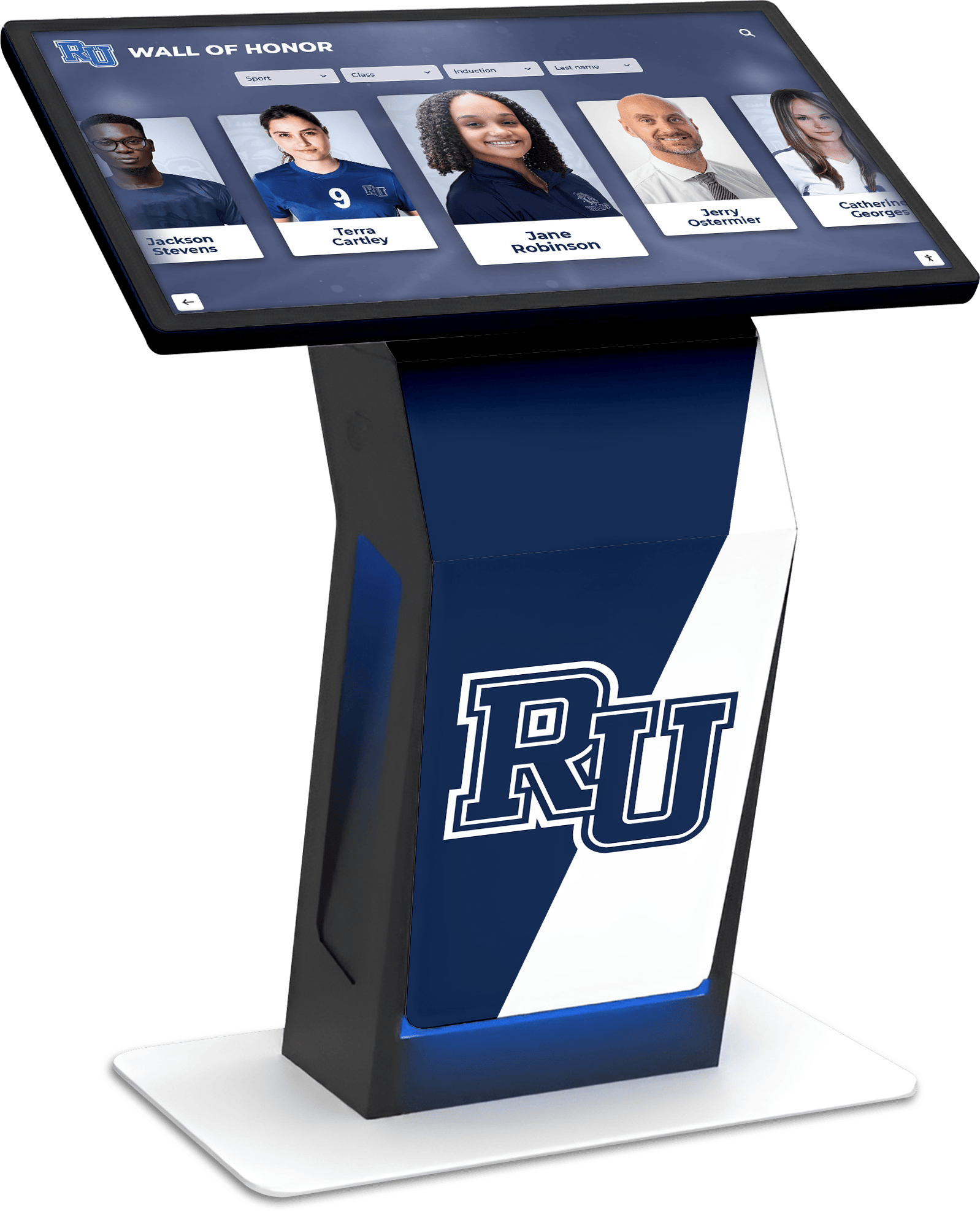
Building Effective Team Photos Archives
Creating accessible team photo archives requires thoughtful planning around content collection, organization, presentation, and ongoing maintenance. Schools that approach digitization systematically achieve better results and sustained engagement.
Collecting and Digitizing Existing Photos
Most schools possess extensive team photo collections—the challenge lies in locating everything, assessing condition, and systematically digitizing content for preservation and access.
Photo Discovery Process:
- Current trophy cases and hallway displays throughout facilities
- Archive rooms and storage areas holding older materials
- Athletic department files and coach collections
- Yearbook offices maintaining sports photography archives
- Alumni donations of personal photo collections
- Newspaper archives covering team accomplishments
Begin with comprehensive photo inventory identifying what exists, determining condition, noting gaps in coverage, and prioritizing digitization based on value and urgency. Many schools discover forgotten photos during systematic searches—finding treasures in unexpected locations that fill gaps in historical coverage.
Digitization Best Practices:
- High-resolution scanning preserving maximum detail (300-600 DPI minimum)
- Color correction ensuring accurate reproduction
- Careful handling protecting fragile originals
- Consistent file naming enabling systematic organization
- Backup copies stored in multiple locations
- Metadata recording capturing year, sport, and team information
For schools with extensive collections spanning many decades, professional digitization services provide efficiency advantages including specialized equipment preventing damage, experienced technicians ensuring quality, faster processing through optimized workflows, and integrated metadata creation. However, smaller schools or those with limited budgets can successfully digitize photos internally using quality scanners and systematic approaches.
Resources about digitizing yearbooks provide valuable frameworks applicable to team photo digitization as well.
Organizing Photos for Effective Access
Raw digitized photos have limited value without systematic organization enabling discovery. Effective metadata and categorization transform photo collections into searchable archives alumni can navigate intuitively.
Essential Organizational Elements:
- Chronological organization by year and season
- Sport categorization separating different athletic programs
- Team level identification (varsity, junior varsity, freshman)
- Individual identification tagging people in photos
- Event context noting championships, tournaments, or special games
- Coach and staff identification preserving institutional memory
Name tagging proves particularly valuable for alumni engagement. When alumni can search their names and instantly find all photos featuring them, the user experience matches contemporary expectations shaped by social media platforms. This familiar interaction pattern reduces barriers and encourages exploration.
Schools concerned about privacy can implement graduated access levels—providing full access to alumni who register and verify identity while offering limited public access to more recent photos. This balanced approach protects student privacy while maximizing value for legitimate alumni seeking their own photos.
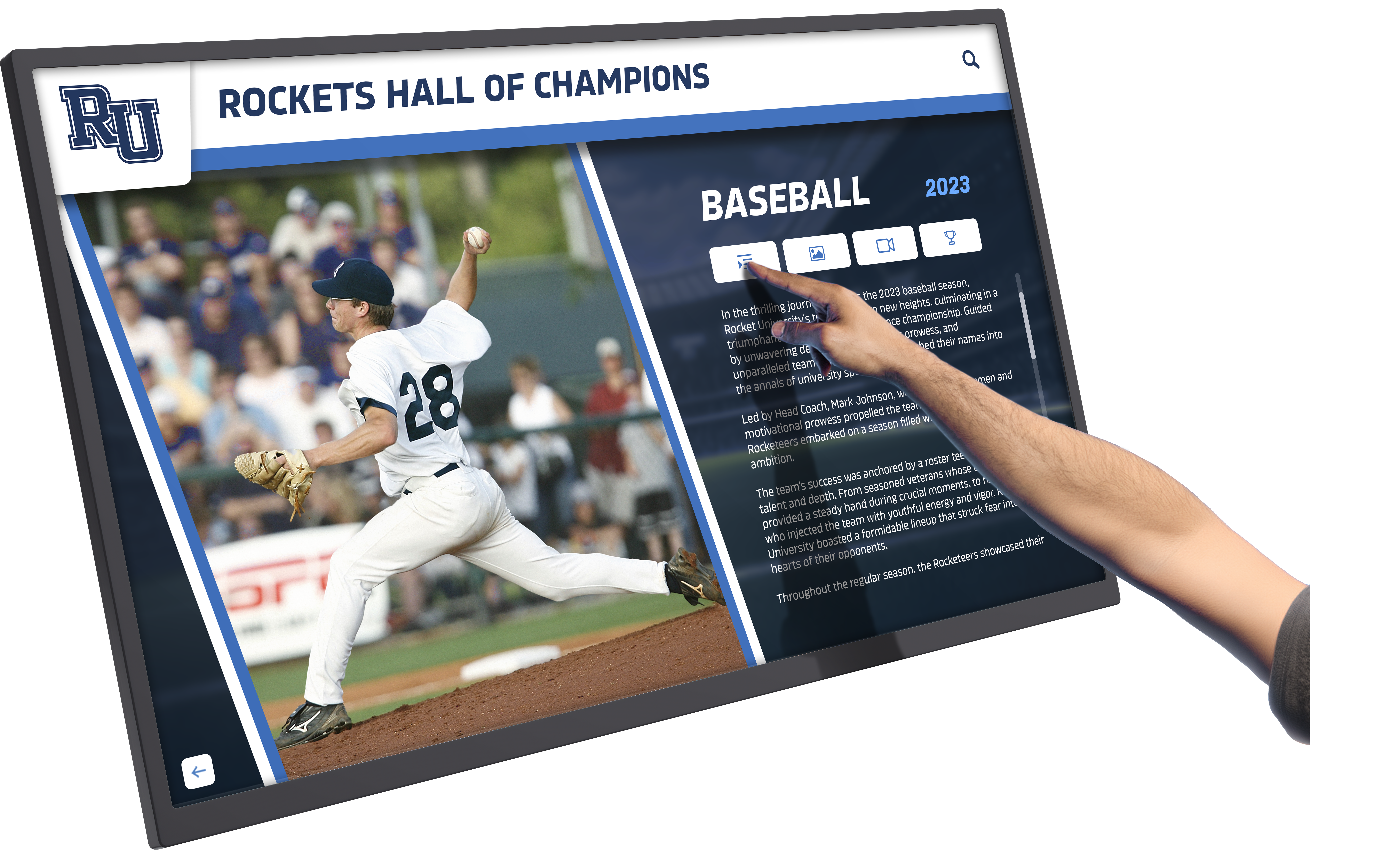
Creating Compelling Digital Presentations
How schools present team photos significantly impacts engagement and emotional resonance. Basic photo galleries function adequately, but thoughtful presentation creates memorable experiences that alumni return to repeatedly.
Effective Presentation Features:
- Clean, intuitive interfaces requiring no instructions
- Large, high-quality photo display emphasizing visual impact
- Contextual information providing team records and accomplishments
- Related content connecting to record boards and achievement recognition
- Timeline visualization showing program evolution across decades
- Comparison capabilities showing uniform changes and facility updates
Interactive touchscreen displays in high-traffic campus locations provide physical access complementing web-based mobile access. Alumni visiting campus can explore comprehensive photo archives on large displays in lobbies, athletic facilities, or alumni centers—creating engaging experiences during tours, events, or casual visits.
Schools implementing interactive recognition displays report that team photo archives become among the most popular features, with visitors spending extended time browsing familiar faces and discovering team history.
Integrating with Broader Recognition Programs
Team photos archives deliver maximum value when integrated with comprehensive recognition programs celebrating athletic achievement, preserving institutional history, and strengthening alumni connections.
Integration Opportunities:
- Athletic record boards linking photos to record holders
- Championship recognition displays celebrating title teams
- Coaching legacy recognition honoring program builders
- Facility naming features showing historical context
- Hall of fame profiles connecting inductees to team photos
- Multi-generational family displays showing legacy attendance
This integrated approach creates cohesive storytelling where team photos provide visual evidence supporting achievement recognition, record boards reference photos of record holders, and championship celebrations include full team photographs. Each element reinforces others, creating richer experiences than isolated displays achieve.
Solutions like Rocket Alumni Solutions specialize in creating these integrated systems where athletic record boards, team photo archives, and hall of fame recognition work together seamlessly within unified platforms accessible both through touchscreens and mobile devices.
Real-World Impact: How Accessible Archives Drive Engagement
The Noble and Greenough story exemplifies broader patterns schools observe when implementing accessible team photo archives. While we cannot share specific case studies or detailed client data, the general impact categories remain consistent across hundreds of implementations.
Measurable Engagement Increases
Schools report dramatic increases in alumni interaction following team photo archive launches. Whereas physical archives might see occasional visitors during reunions or special events, digital archives record thousands of searches and photo views monthly. This increased interaction reflects genuine demand that physical accessibility barriers previously suppressed.
Typical Engagement Patterns:
- Initial surge as word spreads among alumni networks
- Sustained baseline engagement from regular browsing and searches
- Cyclical increases around reunion seasons and homecoming events
- Spikes following promotional communications highlighting new additions
- Gradual growth as more alumni discover availability
Analytics reveal fascinating usage patterns—alumni don’t just search their own names. They browse teammates, explore other sports, compare different eras, and discover broader team history. This exploratory behavior indicates genuine interest extending beyond personal vanity, suggesting photos serve educational and historical purposes alongside nostalgic functions.
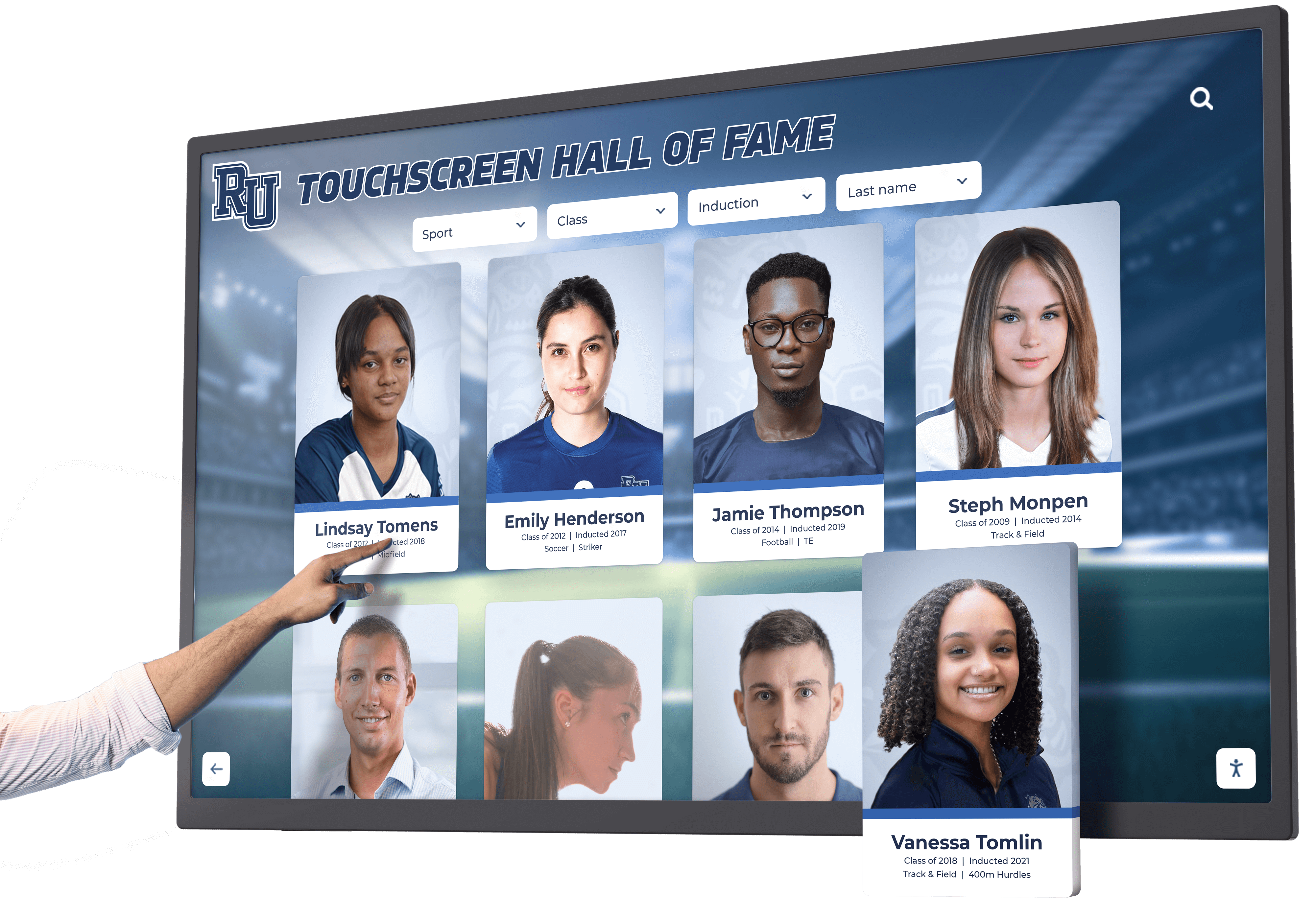
Strengthened Alumni Relationships
Accessible team photos create regular touchpoints maintaining connections between alumni and schools. Each time alumni browse photos or share discoveries, they engage with institutional content and strengthen emotional bonds to their alma mater.
These strengthened relationships manifest in concrete ways including increased reunion attendance, greater responsiveness to fundraising appeals, more volunteer participation, enhanced word-of-mouth recruiting support, and sustained engagement with institutional communications. While team photos alone don’t cause these outcomes, they contribute to overall engagement strategies that build strong alumni relationships.
The emotional resonance of team photos—visual reminders of formative experiences and meaningful relationships—creates positive associations that benefit broader institutional advancement goals. Alumni who regularly engage with team photo archives maintain warmer feelings toward their schools than those with no regular institutional touchpoints.
Unexpected Reconnections and Stories
Perhaps the most meaningful impact comes through individual stories like the Noble and Greenough encounter—unexpected moments when accessible archives facilitate personal connections, trigger important memories, or create family experiences around school history.
Schools report numerous examples of alumni reconnecting with lost teammates through shared photo discoveries, families bonding over multi-generational athletic participation, coaches reflecting on decades of team photos, elderly alumni finding joy in seeing themselves as young athletes, and researchers discovering important historical documentation.
These individual impacts resist quantification but matter deeply to people involved. When schools preserve and share team photos, they honor every student athlete’s experience while creating opportunities for continued connection and meaning-making around shared history.
Technical Considerations for Photo Archive Systems
Schools planning team photo digitization and access systems should consider several technical factors affecting long-term success and user experience.
Platform Selection Criteria
Choose platforms specifically designed for institutional recognition and photo archives rather than generic photo sharing services. Purpose-built solutions provide features educational institutions need including appropriate privacy controls, institutional branding, integration capabilities, and long-term sustainability.
Essential Platform Features:
- Intuitive content management for ongoing photo additions
- Powerful search enabling name-based discovery
- Mobile-responsive design working on all devices
- Sharing capabilities with privacy protections
- Analytics revealing usage patterns and engagement
- Integration options for touchscreen displays and websites
Platforms like Rocket Alumni Solutions deliver comprehensive functionality specifically designed for schools, combining user-friendly interfaces with robust features that scale from small collections to decades of comprehensive photo archives.
Storage and Performance Requirements
High-resolution team photos require substantial storage capacity, and large collections demand efficient delivery systems ensuring fast loading regardless of device or connection speed.
Technical Infrastructure Needs:
- Cloud storage providing reliable access and automatic backup
- Content delivery networks ensuring fast global access
- Image optimization balancing quality and loading speed
- Responsive design adapting to various screen sizes
- Efficient database architecture supporting complex searches
- Scalable capacity accommodating collection growth
Cloud-based platforms eliminate local infrastructure requirements while providing professional-grade reliability, security, and performance that most schools cannot replicate internally. This hosted approach frees institutional IT staff from ongoing maintenance while ensuring optimal user experience.
Privacy and Permission Considerations
Team photos involve student images requiring thoughtful privacy policies balancing accessibility with appropriate protections. Most team photos are historical in nature, featuring adults who participated in athletics during their school years, but recent photos may include current minors requiring additional considerations.
Privacy Best Practices:
- Clear policies defining appropriate use and access
- Graduated access levels based on photo recency
- Opt-out mechanisms for individuals preferring exclusion
- Copyright compliance for professional photography
- Consent documentation for contemporary photo use
- Regular policy review ensuring continued appropriateness
Consult legal counsel when establishing policies, particularly regarding photos of current students and contemporary athletic activities. Historical archives featuring adults typically present fewer privacy concerns than recent materials, but institutional policies should address all scenarios comprehensively.
Maintenance and Growth of Photo Archives
Launching team photo archives represents just the beginning—sustained value requires ongoing maintenance, regular additions, and continuous improvement based on feedback and usage patterns.
Regular Content Additions
Establish systematic processes for adding new team photos immediately following each athletic season. This ensures archives remain current and comprehensive rather than becoming static historical resources disconnected from contemporary athletics.
Ongoing Collection Processes:
- Automated workflows capturing current season team photos
- Partnership with athletic photographers ensuring access
- Annual scanning of physical photos from recent seasons
- Alumni donation programs accepting historical photos
- Social media monitoring discovering shared photos
- Newspaper archive searches finding published team coverage
Schools that update photo archives consistently see sustained engagement as alumni return regularly to discover new content, check for photos from recent reunions or events, and monitor their children’s athletic participation.
Community Contribution Programs
Alumni often possess team photos not in official school archives—personal copies, informal team gatherings, or photos from special events. Creating mechanisms for alumni contributions can significantly expand collections while building engagement through participatory preservation.
Contribution Strategies:
- Online submission portals accepting digital photo uploads
- Scanning events at reunions capturing personal collections
- Social media campaigns requesting photo sharing
- Recognition of contributors encouraging participation
- Quality review ensuring appropriate submissions
- Integration workflows adding contributed photos to main archives
Emphasize that contributors retain rights to personal photos while granting schools permission for archival use and display. This respectful approach encourages sharing while honoring alumni ownership of personal materials.
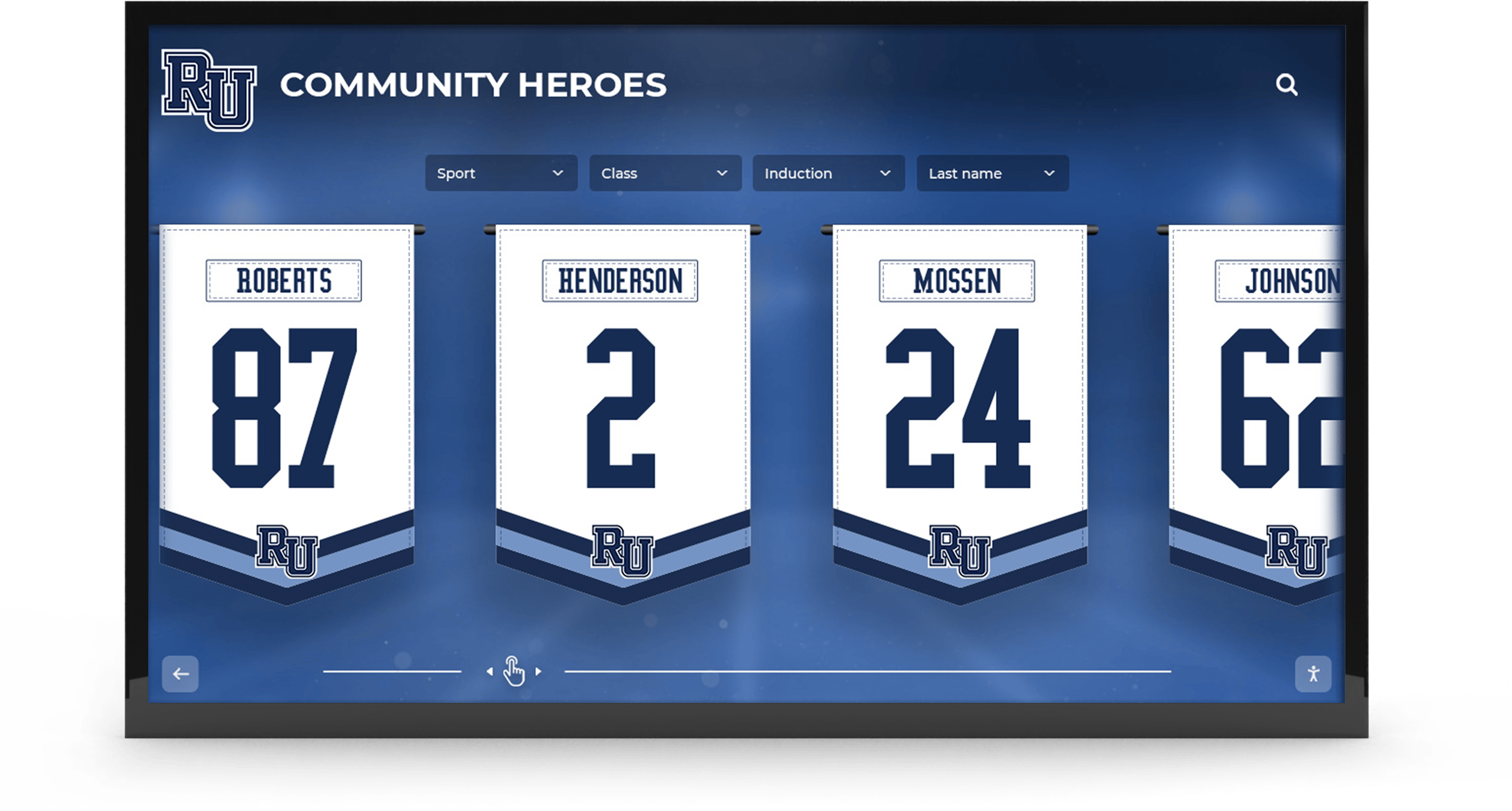
Analytics-Driven Improvements
Monitor usage patterns and engagement metrics to understand how alumni interact with photo archives, which features they value most, and where improvements would enhance experience.
Valuable Analytics Insights:
- Popular search terms revealing alumni interests
- Most-viewed photos and time periods
- Average session duration indicating engagement depth
- Geographic access patterns showing alumni locations
- Device types informing optimization priorities
- Traffic sources revealing effective promotional channels
Use these insights to prioritize enhancements, promote underutilized content, improve navigation and search functionality, and demonstrate value to stakeholders and potential funders. Data-driven improvements ensure photo archives continue meeting evolving alumni needs and expectations.
Getting Started: Implementation Roadmap
Schools ready to make team photo archives accessible can follow systematic approaches ensuring successful outcomes while managing resource constraints.
Phase 1: Assessment and Planning (1-2 months)
- Inventory existing team photos across all locations
- Assess collection condition and identify priorities
- Establish budget and resource allocation
- Research platform options and capabilities
- Develop project timeline and milestones
Phase 2: Pilot Digitization (2-4 months)
- Digitize priority photos from recent decades
- Establish metadata standards and organization
- Test platform functionality and user experience
- Gather feedback from pilot alumni users
- Refine processes based on lessons learned
Phase 3: Comprehensive Implementation (6-12 months)
- Complete systematic digitization of all photos
- Launch public access to comprehensive archives
- Promote availability through multiple channels
- Install touchscreen displays in campus locations
- Train staff on content management and updates
Phase 4: Ongoing Operations (Continuous)
- Add new team photos following each season
- Monitor engagement and gather user feedback
- Implement enhancements based on analytics
- Expand integration with other recognition programs
- Maintain and preserve digital archives
This phased approach delivers value quickly through pilot implementations while building toward comprehensive long-term solutions serving entire communities.
The Moment That Matters: Mobile Access Enables Connection
The Noble and Greenough story demonstrates fundamental truth: when schools make team photos accessible, they enable meaningful connections that wouldn’t otherwise occur. That alumnus might have gone his entire life never seeing those photos again—or might have eventually planned a special trip to campus, scheduled time with staff, and visited physical archives in a scheduled, transactional manner.
Instead, a spontaneous moment became an emotional experience. Seconds of mobile searching delivered years of memories. A simple gesture—“let me show you”—created family conversations and renewed institutional connections. The alumnus didn’t just see his photos; he shared them with people he loves, creating lasting positive associations with his school experience.
This is what accessible team photo archives provide: not just preservation, but activation of memories and relationships. Not just historical documentation, but living connection between past and present. Not just photos stored safely, but experiences that matter to real people in real moments.
Every student athlete deserves their photos preserved and accessible. Every alumnus deserves the opportunity to revisit their team photos and share them with family. Every school benefits when alumni maintain strong emotional connections to their athletic experiences and institutional communities.
Digital recognition platforms like Rocket Alumni Solutions make these connections possible through intuitive, mobile-accessible systems designed specifically for schools. Whether alumni browse on phones during chance encounters, explore touchscreens during campus visits, or search comprehensive archives from across the country, accessible team photos create engagement, strengthen relationships, and honor the experiences that shaped who people became.
Start preserving your team photos today, and enable countless moments like the one we witnessed in Boston—unexpected encounters that remind everyone why school memories matter and why accessibility transforms static archives into living connections.
